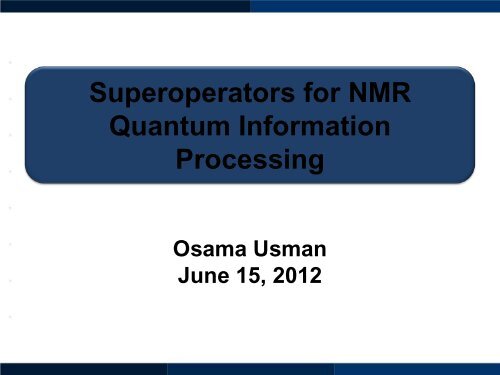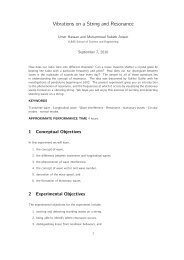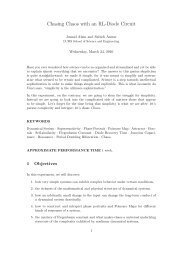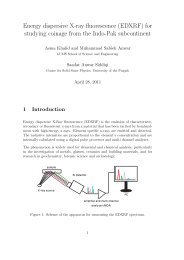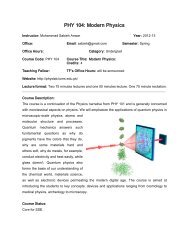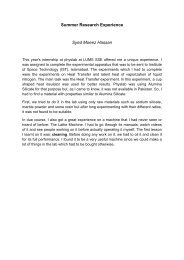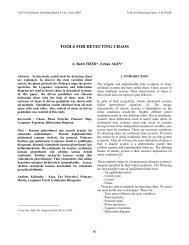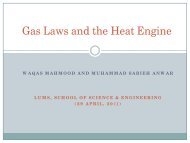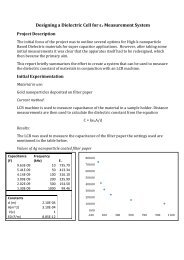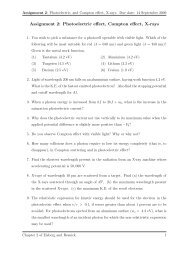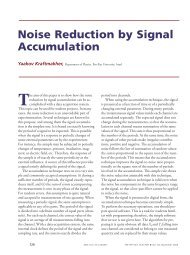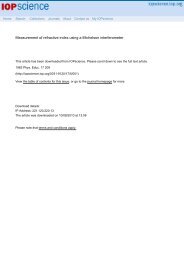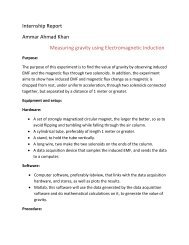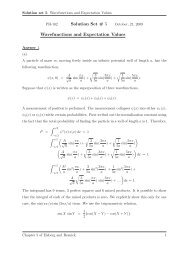Superoperators for NMR Quantum information processing
Superoperators for NMR Quantum information processing
Superoperators for NMR Quantum information processing
Create successful ePaper yourself
Turn your PDF publications into a flip-book with our unique Google optimized e-Paper software.
<strong>Superoperators</strong> <strong>for</strong> <strong>NMR</strong><br />
<strong>Quantum</strong> In<strong>for</strong>mation<br />
Processing<br />
Osama Usman<br />
June 15, 2012
Outline<br />
1 Prerequisites<br />
2 Relaxation and spin Echo<br />
3 Spherical Tensor Operators<br />
4 <strong>Superoperators</strong><br />
5 My research work<br />
6 References.
<strong>NMR</strong><br />
• <strong>NMR</strong> is a phenomenon in which the<br />
resonance frequencies of nuclear magnetic<br />
systems are investigated.<br />
• <strong>NMR</strong> always employs some <strong>for</strong>m of<br />
magnetic field (usually a strong externally<br />
applied field B 0 and a RF field)<br />
• Nucleis have a magnetic moment and spin<br />
angular momentum
Random direction of spin polarization in<br />
the absence of magnetic field.
Net magnetic moment from small<br />
z<br />
excess of Nuclei in +1/2 state.<br />
-1/2<br />
B 0 Applied<br />
magnetic field<br />
Spin States Split in the presence of B 0<br />
M 0<br />
y<br />
x<br />
+1/2
Longitudinal and Transverse<br />
Magnetizations
Most commonly studied nuclei
Applications of <strong>NMR</strong><br />
• Physics<br />
Condensed matter physics<br />
• Chemistry<br />
Identification of material<br />
• Biophysics<br />
Analysis of Protein structure<br />
• Medical<br />
MRI (Magnetic Resonance Image)
Interactions in <strong>NMR</strong><br />
Internal<br />
Interactions<br />
NRM<br />
Interactions<br />
External<br />
Interactions<br />
1. Chemical shift 1. Applied Magnetic field<br />
2. J-Coupling 2. RF field<br />
3. DD-Coupling
Relaxation<br />
• T1 spin-lattice (relaxing back to precessing<br />
about the z axis)<br />
Recovery of Z component of magnetization.<br />
• T2 spin-spin (fanning out)<br />
Decay of x , y component of magnetization.
Spin Echo
Density Matrix Formalism<br />
• A tool used to describe the state of a spin ensemble, as<br />
well as its evolution in time.<br />
• Average of any observable<br />
• For any state<br />
Diagonal elements = probabilities<br />
[1]<br />
Off-diagonal elements = "coherences"<br />
(provide info. about relative phase)
Spherical tensor operators.<br />
• Tensors are very useful simplifying tools that<br />
encountered in spherical symmetric problems.<br />
• Any spherical tensor operator can be found by<br />
• Commutation relations with angular momentum<br />
operator.<br />
[2]
Trans<strong>for</strong>mation of Spherical tensor<br />
operators<br />
Wigner rotation matrices<br />
Reduced rotation matrix elements<br />
[2]
Total Hamiltonian in terms of Spherical<br />
tensor operators.<br />
[3]
<strong>Superoperators</strong><br />
• Liouville-von Neumann equation<br />
• We define a superoperator<br />
[4]
Matrix representation of<br />
<strong>Superoperators</strong><br />
‣ <strong>Superoperators</strong> belong to the superoperator space.<br />
‣ The difference between the Superoperator space and<br />
Hilbert space is dimensionality.<br />
‣ Different physical conditions.<br />
‣ Matrix representation
Table<br />
Name<br />
Continuous<br />
representation<br />
Continuous<br />
scalar<br />
product<br />
Discrete<br />
representation<br />
Discrete scalar<br />
product<br />
Superoperator<br />
Space<br />
superoperators<br />
n²×n² matrices<br />
Liouville space<br />
operators,<br />
Density<br />
matrices<br />
n×n matrices<br />
Hilbert space wavefunctions n ‐vectors
Long lived Singlet states in solution<br />
<strong>NMR</strong><br />
Singlet and Triplet states<br />
Two coupled spins
Density operator <strong>for</strong> Spin pair
Equation of Motion<br />
Liouvillian Space operator<br />
Coherent Effects<br />
Incoherent Effects<br />
Dipole-dipole<br />
relaxation<br />
External random<br />
field relaxation
For DD-relaxation<br />
Relaxation Superoperator<br />
For ERF-relaxation<br />
[5]<br />
Autocorrelation function<br />
Correlation time
Relaxation of singlet-state population
Final matrix of the coherent Liouvillian<br />
Superoperator.<br />
• Shows the conversion of singlet population to singlettriplet<br />
zero-quantum coherence then to triplet<br />
population.
Final matrix of the evolution of spin<br />
density operator.
Signal Obtained
Advantages and applications of longlived<br />
states<br />
‣ Store in<strong>for</strong>mation up to 40 times longer than T1.<br />
‣ Can be created in both high or low magnetic fields, the<br />
latter case very interesting <strong>for</strong> applications on humans.<br />
‣ For the study of molecular transportation and storage<br />
of polarized nuclear spin coherence.<br />
‣ Can be used <strong>for</strong> the investigation of slow-cross<br />
relaxation between different molecules in solutions.
<strong>NMR</strong> <strong>for</strong> <strong>Quantum</strong> In<strong>for</strong>mation<br />
Advantages<br />
Disadvantages<br />
1. Physics of <strong>NMR</strong> 1. Noisy signal<br />
is well described.<br />
2. Long decoherence times 2. No entanglement.<br />
3. Small quantum computer 3. Limited measurement.<br />
is easy to construct.
Why <strong>NMR</strong>?<br />
A major requirement of a quantum in<strong>for</strong>mation/computer<br />
is that the coherence should last long.<br />
‣ Nuclear spins in liquids retain coherence ~ 100’s<br />
millisec and their longitudinal state <strong>for</strong> several<br />
seconds.<br />
‣ A system of N coupled spins (each spin 1/2) <strong>for</strong>m an<br />
N qubit <strong>Quantum</strong> Computer.<br />
‣ Unitary Trans<strong>for</strong>m can be applied using R.F. Pulses<br />
and various logical operations and quantum algorithms<br />
can be implemented. [7]
References<br />
1. Levitt M.H, Spin Dynamics Basics of Nuclear Magnetic<br />
Resonance, John Wiley & Sons Ltd, 2001.<br />
2. C.P. Slichter. Principles of Magnetic Resonance. Harper , Row,<br />
1963.<br />
3. Melinda J. D, Introduction to Solid-State <strong>NMR</strong> Spectroscopy,<br />
John Wiley & Sons Ltd, 2004.<br />
4. Mayne C.L, Liouville Equation of Motion, Encycl. Nucl. Mag.<br />
Res, 2717-2730.<br />
5. M. Carravetta and M. H. Levitt. Theory of long-lived nuclear spin<br />
states in solution nuclear magnetic resonance. i. singlet states<br />
in low magnetic field. J. Chem. Phys., 122:214505, 2005.<br />
6. Jeener J, <strong>Superoperators</strong> in Magnetic Resonance, Adv. Mag.<br />
Res, 10 (1982), 1-51.<br />
7. Jones J.A, <strong>Quantum</strong> Computing with <strong>NMR</strong>, Prog. <strong>NMR</strong><br />
Spectrosc. 38,325-360(2001).
THANKS FOR YOUR PATIENCE


